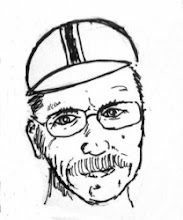In the old days, when what we now call "Friction Shifting" was just called "Shifting", the bicycle shifter was a pretty simple mechanism. A lever, held in place by either friction or a ratcheting mechanism, would pull on a length of cable and the cable in turn would move the derailleur. Riders shifted by sound and feel to get the chain to settle into just the right spot on the desired gear. If the cable housings settled in a bit (something often mis-termed as "cable stretch") the rider would just move the lever to a slightly different spot, often without even conscious thought. It's a system that still works quite well and many folks, including my friend Jan Heine, speak quite eloquently on
the virtues of friction shifting.
Friction shifting takes a bit of getting used to and in the 1980s indexed shifting became the dominant way that riders conveyed their gearing desires to their machines. If the old lever was like a radio dial that you'd turn until the station sound came in clearly, the new levers were the push button that would take you right to the exact frequency of the station. When properly adjusted, an index shifter clicks you into the right gear at the push of a button.
Indexed shifting requires that the cable tension be correct and the housing length constant, so modern shift housing is constructed to be "compressionless". It's not 100% compressionless, but for the imperfect world in which we live, it's close enough. As with many things bike related, Sheldon Brown has an excellent article in which
he discusses bike cables. The important lesson there is that brake & shift housing is doing different jobs an on modern bikes, they have different construction. NEVER use modern shift housing for brakes!
When index shifting works, it tends to work well but when it doesn't work, it is often a case of the cable tension being off. Again, Sheldon has an extensive article that
explains in detail most derailleur adjustments. Sharp-eyed readers will note that Sheldon and I differ on our opinions of the proper spelling of derailleur, but that is one of the rare areas where he and I disagree. He's probably right, but I'm stubborn.
I'm always amazed when I find a bicycle subject Sheldon didn't address completely in his too brief life but in searching for "Gummy Indexed Shifters", I didn't find what I thought was common knowledge. In the spirit of Sheldon, I'll tell what I know about fixing gummy shifters.
The inside of an index shifter looks like a little clock. There are tiny gears and springs and little ratcheting pawls that grab the gears. Sometimes a gear may chip a tooth or a spring may break. If you have a Campagnolo shifter, the hands of a watchmaker, the patience of a saint and the proper spring, you may be able to fix it. If you have a Shimano shifter, the folks at Shimano will sell you a whole new shifter. Before you launch into a Campagnolo is great and Shimano is evil rant, price out the cost of that little spring and what current shop labor rates are in your area.
Most often though, the problem with a shifter isn't that anything is broken, it is that the ratcheting pawl is not springing down to grab the gear. The most common cause of this is age and lack of use. When bikes sit for a long period of time, like in storage over the winter, the grease on those pawls gums up and becomes less like grease and more like glue. The symptom is often a gummy feeling in the lever, the lack of that crisp "click" sound and an inability of the bike to shift into one or more of its gears. The solution is to flush out the gummy grease and get some new lubrication on the working parts.
If this article helps even one person keep an old bike going, then I figure I've done my job.
Keep 'em rolling,
Kent "Mountain Turtle" Peterson
Issaquah WA USA









